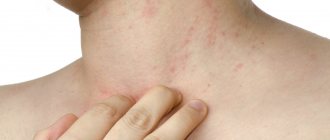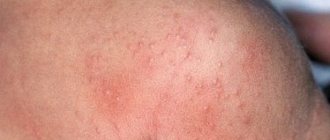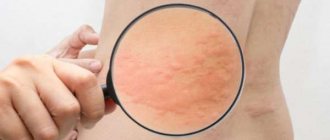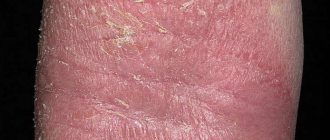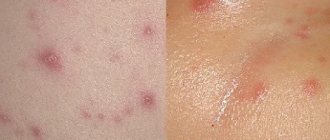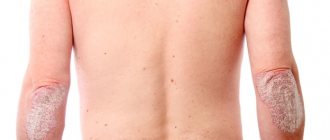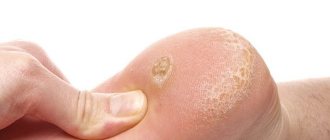Allergic contact dermatitis is a type of reaction of the body to direct exposure of the skin to a specific irritant. This is one of the most common dermatological diseases that occur with damage to the epithelium. This inflammation develops quite slowly, with sufficiently long and frequent contact with the irritant. The rash with this type of allergic contact dermatitis is limited to one area and almost always has a distinct outline.
Symptoms of this pathology manifest themselves in the form of severe itching, redness, and the appearance of blisters filled with liquid, combined with erosions. This disease affects people who are predisposed to skin rashes and allergic reactions to an irritating allergen.
Description
You may be interested in: Curvature of the penis: causes, symptoms and treatment features
This disease occurs when the skin is exposed to certain environmental conditions. Pathology can occur due to prolonged exposure to temperature, mechanical factors, current, various irradiations, aggressive acids and strong alkalis, infectious processes of any pathogenesis.
You may be interested in: Hydrothorax of the lung: causes, symptoms, diagnosis and treatment methods
The mechanism of allergic contact dermatitis is quite simple. Contact with an irritating substance on the surface of the skin or too close contact with it triggers a reaction that manifests itself in the form of inflammation.
Channel PROGRAMMER'S DIARY
The life of a programmer and interesting reviews of everything. Subscribe so you don't miss new videos.
The ICD-10 code for allergic contact dermatitis is L23.
Types of pathologies
Symptoms and treatment for contact dermatitis depend on the type of contact dermatitis. There are two of them:
- Simple, which forms on the skin due to its contact with any irritating substance. In this case, the first symptoms appear immediately and are usually located in the area of influence of the stimulus. Such irritants are certain substances: detergents, acids.
- Allergic, manifested in the form of an allergic reaction. The symptoms are due to a slow allergic reaction, a process in which specific antibodies are first produced, which then trigger an inflammatory process.
The boundaries of inflammation usually cover the area of the contact zone. This reaction is caused by household chemicals and industrial chemicals.
Formation of papules and small vasicles on the skin, from which exudate is released
Causes
The pathological condition of the skin is a pronounced reaction of the body to pathogenic allergens in any form. Often these substances include:
- latex - gloves, baby pacifiers, condoms, clothing;
- care cosmetics - soaps, shampoos, creams, oils, perfumes, gels;
- nickel - rings, earrings, pendants and other jewelry;
- some medications - corticosteroids, antibiotics;
- household chemicals - polishes, detergents and cleaners, powders, concentrates;
- clothing - items made of rubber, synthetics and other materials;
- other types of objects - paints, inks.
In addition, even some plants can lead to the development of allergic contact dermatitis, for example, hogweed, ash, primrose, and flower pollen.
You may be interested in: Glucosamine sulfate: instructions for use, analogues and reviews
In general, this pathology can arise due to the influence of absolutely any substance on the body. It is noteworthy that the determining condition in this matter is not the chemical composition of these objects, but the body’s sensitivity to them.
Classification
Based on the nature of symptoms, the following forms of the disease are distinguished:
- acute contact dermatitis (symptoms of inflammation appear immediately after contact with the irritant);
- chronic contact dermatitis (inflammation develops gradually, unpleasant symptoms increase over time).
In accordance with the reasons that cause inflammation of the skin, the following types of contact dermatitis are distinguished:
- Simple. Inflammation of the skin develops due to contact with an irritant. These can be alkalis, acids, or any other chemicals.
- Allergic. Dermatitis in this case is an individual reaction of the body to contact with metals, some cosmetic substances, paints, plants, etc.
- Photo contact. Skin inflammation develops due to exposure to ultraviolet radiation. The disease in this form is quite difficult to diagnose due to the fact that symptoms appear only after the skin is exposed to sunlight.
Dermatitis can develop under the influence of ultraviolet rays
Depending on the nature of the substance that gets on the skin, as well as the individual characteristics of a particular person, dermatitis can develop in three forms:
- erythematous (redness and swelling of the skin in the area of contact with the irritant);
- bullous (vesicles filled with clear liquid appear on the skin);
- necrotic (the most complex form of contact dermatitis, characterized by the formation of ulcerations).
Contact dermatitis develops most often on the hands. Less commonly, inflammation of the skin can be observed on the face, legs, head, groin, etc. Under the influence of fabric dyes or other substances included in underwear, the disease can develop on the genitals and labia mucosa.
Chronic contact dermatitis of the hands is a common occupational pathology. Inflammation of the skin develops gradually in dishwashers, service station workers, manicurists, hairdressers, etc.
Pathogenesis
The irritating substance affects the skin itself, but the disease provokes pathological changes that affect the entire body. After the interaction of the allergen with the epithelium, the first symptoms of the pathology begin to appear approximately two weeks later. Although an allergic reaction and sensitization may well appear earlier. Here everything is determined by the strength of the stimulus’ influence on the body, which can be significantly weakened due to:
- decrease in the protective properties of the immune system due to chronic diseases and inflammatory phenomena;
- predisposition to allergies;
- thinning of the upper layer of the epidermis and other pathologies.
Allergic contact dermatitis (ICD-10 code - L23) with excessive sweating can occur due to wearing items of clothing made of dyed materials. Among other things, it is worth highlighting the internal conditions that contribute to pathology: serious disruptions in the functioning of the endocrine apparatus, metabolic failures, and vitamin deficiencies.
Causes
The allergen initially enters the bloodstream, where it interacts with blood proteins. These newly formed compounds are the trigger for allergies.
The most common allergens are:
- Plants . They contain fat-soluble substances in their stems and leaves that sensitize the dermis upon contact. Active allergens are present in the following plants: poison ivy, tulip, chrysanthemum, poison sumac, primrose, citrus fruits, oak. An allergic reaction is triggered by juice, pollen, and smoke from burning. Substances released by plants can act as photosensitizers. They can cause solar dermatitis.
- Cosmetics, perfumes . They contain a huge number of components that cause a reaction on the epithelium in men and women (they also have symmetrical dysmenorrheic dermatitis).
- Paints . The strongest allergen used in the manufacture of paints is considered to be dinitrochlorobenzene. Allergic dermatitis can be provoked by many dyes used to color fabrics, leather, and various products;
- Formalin . This remedy is often used in medicine and various industries.
- Metals . Nickel and chromium salts are considered common allergens. These metals are often used in the manufacture of jewelry, watches, eyeglass frames, bracelets, scissors, hairpins, and dentures. Less often, allergic manifestations are provoked by the following metals: copper, cobalt, uranium, iron, mercury, cadmium, beryllium, platinum. Very rarely, reactions to aluminum and silver may occur.
- Polymers (natural, artificial) . They often act as the cause of occupational (contact allergic) dermatitis. In everyday life, allergic manifestations occur only occasionally.
- Medications . Allergic reactions can occur to antibiotics, vitamin B12, sulfa drugs, aminophylline administered intravenously.
Very often, allergic contact dermatitis appears as an occupational disease. The high-risk group includes:
- cooks;
- cosmetologists;
- medical workers;
- builders;
- hairdressers;
- machinists.
People in these specialties often come into contact with substances that are considered strong allergens (carbon mixtures, nickel, epoxy resins, formaldehyde, thiurams).
Dr. Komarovsky will tell you how to find the cause of allergic dermatitis in the video below:
Symptoms of allergic contact dermatitis
Treatment of this pathology depends, of course, not only on the causes, but also on the signs of the disease. That is why it is so important to promptly identify the symptoms of the disease and seek help from a specialist.
Taking into account the course of the disease, doctors distinguish between chronic and acute allergic contact dermatitis. These varieties are determined by the regularity of interaction with the allergen.
In the acute form of the disease, localization of contact with an irritating substance becomes a prerequisite for pathological changes in the skin. In some cases, these phenomena may spread beyond the affected area. Another distinctive feature of the pathology is the presence of distinct outlines of the injured area.
The first symptoms of allergic contact dermatitis appear as redness and swelling of the skin. After some time, papules appear and fill with liquid quite quickly. Then they are converted into bubbles. And after tightening, crusts appear on them, which cause unbearable itching. This whole process ends with severe peeling of the skin.
Forms of flow
Treatment of contact dermatitis is closely related to the form of its occurrence. She may be:
- acute;
- chronic.
The acute form includes, for example, a burn from an acid or alkali. In this case, changes appear on the skin in the form of red plaques with clear boundaries. The plaques are located close to each other. At the same time, they can be covered with small scales.
The chronic form is the result of repeated interaction of the skin with irritants of low strength . Here it is observed:
- thickening of the epidermis;
- strengthening of skin pattern;
- the appearance of parallel lines or diamonds on the skin;
- multiple arrangement of flat or rounded-top papules.
Important! A qualified dermatologist must determine the exact type of disease and prescribe the correct treatment after studying the tests.
The skin in the chronic form of the disease is susceptible to peeling and further thickening
Other signs of illness
You will be interested: Vishnevsky Institute in Moscow: services, doctors, address, patient reviews
The chronic form of the pathology arises as a result of prolonged exposure to an irritating substance when an allergic reaction has already appeared. This type of dermatitis is characterized by the spread of inflammation to areas not in contact with the allergen.
Regarding the foci of damage on the epidermis, they have blurred boundaries. The development of the pathological process occurs in the case of severe sensitization. The dermis becomes covered with neoplasms, papules and seals. The skin becomes too dry, its pattern changes.
Incessant itching leads to secondary trauma to the dermis as it is scratched. This disease can be identified in a timely manner and distinguished from others using photographs of allergic contact dermatitis, in which visual symptoms can be seen.
Differential diagnosis
Simple contact dermatitis is diagnosed by a dermatologist based on characteristic clinical symptoms and the presence of a connection between the occurrence of characteristic signs of pathology and the presence of an irritating substance.
If an allergic form is suspected, an allergist is involved in consultation. Using a special test (skin allergy test method), he identifies the contact substance. Avoiding interaction with it is the main component of treating the disease.
Skin allergy test method
In the presence of purulent inflammation, the contents separated from the affected area are collected. Using the biological material obtained in this way, bacteriological seeding is performed. Deciphering its results makes it possible to select effective antibacterial agents and include them in therapeutic regimens.
In the bullous form, a histological examination of the contents of the blisters is required. If contact dermatitis develops, it contains accumulations of neutrophils. The chronic form is diagnosed when symptoms of acanthosis and hyperkeratosis are present, when dilation and elongation of the dermal papillae are detected.
It is important at the stage of diagnostic examination to differentiate contact dermatitis from neurodermatitis, scabies, and eczema.
Clinical picture
Pathology manifests itself as the body's response to an irritating substance. This effect occurs through direct contact with the skin, and even for a short time.
With this type of dermatitis, a person develops high sensitivity to a certain substance, which as a result becomes an allergen. It is noteworthy that this phenomenon is quite specific and originates in relation to a single object or a certain group of objects.
At its core, dermatitis is an allergic reaction itself, which is characterized by a delayed action. The body's reaction under such conditions occurs, as a rule, without the participation of antibodies; it involves other elements - specific immune cells. That is why microscopic examination in the lesion shows the presence of a significant accumulation of relevant microorganisms - this is one of the characteristic signs of such dermatitis.
Treatment
Remove allergic dermatitis
possible at home, as an exception to the rules of the situation of its development against the background of other more significant diseases and original conditions.
Treatment
The disease first begins with avoiding contact with the allergen; it is also important to follow a dietary diet.
Drug treatment
- Glucocorticosteroids. To eliminate symptoms (even without installing an allergen), glucocorticosteroid ointments, creams or aerosols are used. Hormonal drugs are prescribed in short courses to avoid addiction. Hydrocortisone, Dermovate, Elokom, Betamethasone, Akriderm, and others.
- Antihistamines. To reduce the severity of swelling and itching. New generation antihistamines do not cause drowsiness and do not reduce the patient’s comfort in life. Cetrin, Zodak, Claritin, Suprastin, Fenkarol, Astemizole and others.
- Detoxification medications are administered intravenously or intramuscularly to reduce sensitivity to the identified allergen. Calcium chloride is used (5 milliliters of the substance intravenously using a dropper, slowly, over 4-6 minutes), sodium thiosulfate (5-50 milliliters intravenously, depending on the severity of the allergic manifestation), calcium gluconate (1-3 grams 2-3 times throughout the day intramuscularly or intravenously).
- Enzymes are prescribed when the basis of the disease is a problem with the pancreas. Creon, Festal, Mezim, Panzinorm, Pancreatin and others.
- Prebiotics and enterosorbents are prescribed to restore intestinal microflora and remove toxins from the body. Linex, Laktiale, Enterosgel, Polysorb, Laktofiltrum and so on.
- Homeopathic remedies are selected individually depending on the age and condition of the patient, and the parameters of the disease. May be prescribed: Iricar cream (for severe redness, itching), Antimonium crudum (black antimony sulfur for rashes with the formation of blisters and pustules, itching, crusts), Arsenicum album (for various rashes and skin lesions) and others.
- Antifungal drugs and products with a softening and protective effect destroy pathogenic microbes, moisturize, soften and protect the skin. The most effective are: Eplan, Zinc ointment, Exoderil, Bepanten, Epidel, Desitin and others.
Traditional treatment
The use of folk remedies for the treatment of dermatitis of an allergic nature is very good at the stage when you need to alleviate symptoms.
To do this use:
- decoctions of herbs for drinking from string, tricolor violet, currant bark, chamomile, viburnum bark or licorice root;
- compresses with infusions of horsetail herbs, elecampane roots, calendula, lemon balm, and felt burdock;
- homemade ointments made from chicken, pork or goose fat, sea buckthorn oil;
- baths with the addition of a decoction of nettles, chamomile flowers, oregano, blue cornflowers, wild rosemary leaves, and valerian;
- aromatherapy using geranium, lavender or sandalwood oil.
Diagnostics
Pathology can be easily detected by its characteristic signs. Any patient can identify the corresponding symptoms even with the help of photos of allergic contact dermatitis presented in this article.
Using skin tests, you can determine the specific cause of the pathology. To carry out the examination, special test strips coated with allergens are used. The skin should first be cleaned, and then the material should be glued. An allergic reaction can be identified by signs occurring at the site of contact: swelling and redness.
This diagnostic method is extremely important for the subsequent determination of a treatment regimen. Specialists determine the diagnosis and prescribe specific therapy individually for each patient.
Symptoms of an allergic skin reaction
- Itching and scratching marks with long-term persistence of the inflammatory process
- Redness of certain areas of the skin
- Swelling, edema
- The appearance of rashes of various shapes and sizes (urticaria-type blisters and small blisters, papules)
- Erosion on the skin after opening of the blisters, weeping with subsequent drying of the inflammatory exudate into crusts
- Peeling and cracking of the skin
- If left untreated, a purulent infection may develop
Other techniques
As a differential diagnosis of allergic contact dermatitis and detection of concomitant pathologies, auxiliary examinations are carried out:
- stool analysis for dysbacteriosis;
- clinical and biochemical studies of urine and blood;
- blood test for sugar levels.
If necessary, an examination of the thyroid gland is also performed to determine its abilities and a thorough examination of the digestive tract.
Allergic contact dermatitis in children, as well as in adults, requires the detection of certain allergens and their immediate elimination. After all, exposure to them for too long can lead to more serious and widespread consequences, characteristic of similar reactions of the whole organism. For example, an allergy can trigger anaphylactic shock, asthma, or Quincke's edema.
How is therapy carried out in children?
To carry out adequate treatment in children, they turn to specialists. They will conduct a comprehensive examination and then prescribe a course of treatment.
In order to improve the general condition of the child, measures are taken to improve the psychological condition of all family members. Be sure to make sure your child eats properly.
There are a number of products that are allowed to be given:
- green apples;
- lean meat.
Eliminate mayonnaise, vinegar, cheese, and sweets from his diet.
During periods of exacerbation, dermatologists prescribe antihistamines. All modern medicines are safe for children of any age.
General principles of treatment of allergic contact dermatitis
Photos of symptoms will help the patient to identify the disease in time and begin therapy. This is very important to prevent the development of a chronic form of pathology and all kinds of complications. In order for the treatment of allergic contact dermatitis to be truly successful and effective, the causative agent of the disease must be completely eliminated. For example, if some jewelry acts as an allergen, the patient will have to stop wearing it.
If an irritating substance accompanies the patient’s professional activities, he needs to take care of his own protection from allergy-provoking factors. This can be done using protective clothing, gloves or a mask.
Is a diet prescribed?
Having discovered allergic dermatitis in a patient, he is prescribed a strict diet. If the symptoms were caused by a specific product, you need to completely get rid of it.
However, doctors are not always able to eliminate this product, so they recommend sticking to one diet.
All products can be divided into three types - low, high, medium.
Highly allergic products - chocolate, milk, eggs. In addition, ingredients such as mushrooms, honey, nuts are also included in this list.
With this disease, you should completely abandon all of the above products. It should not be smoked or highly salted.
It is also better to abstain from drinking alcohol.
See what the symptoms of Quincke's edema look like in the photo. What are the causes of dermatitis on the hands? The answer is here.
What are the treatments for atopic dermatitis in children? Details in the article.
Recommendations for the patient
If an allergen gets on the dermis, you should rinse the skin as quickly as possible using soap, and then gently dry the damaged area.
If the body has a negative reaction to household chemicals, you should refrain from using aggressive agents, replacing them with hypoallergenic analogues. If this is not possible, you must always use gloves when in contact with these substances.
If dermatitis occurs due to an allergy to nickel, then the patient should develop a special diet, the menu of which will exclude products containing it. Prohibited ingredients in this case include: oatmeal, herring, seeds, buckwheat, millet, sardines, liver, tomatoes, cocoa powder, nuts, lentils and soy.
Drug therapy
As for the medicinal treatment of allergic contact dermatitis, antihistamines are primarily used here, and it is advisable to opt for those options that belong to the modern generation. For example, the drugs Erius and Zyrtec are considered very effective. The thing is that modern medicines do not have the side effects that are characteristic of drugs of the previous generation, such as Suprastin, Tavegil, Diphenhydramine. Due to the use of these drugs, patients often experienced symptoms such as drowsiness, vestibular disorders, decreased concentration and loss of performance.
Signs of allergic dermatitis often appear in the form of pain, burning, dry skin and severe itching. To effectively eliminate such symptoms, medications with anti-allergic properties are used, for example, Akriderm GK. It contains antibiotics, topical hormones and antifungal agents. It is thanks to its composition that this drug has not only anti-allergenic, but also antibacterial, anti-inflammatory, and antifungal properties.
Treatment by other means
Patients are always interested in how else contact dermatitis can be treated. Treatment using ointments with glucocorticoids is effective. They eliminate swelling and itching, and have an antiallergic or anti-inflammatory effect.
Selected in accordance with the patient’s condition and the form of the disease:
- weak - hydrocortisone;
- medium strength - Dermatop, Prednisolone, Deperzolon;
- strong - Dermovate, Halciderm.
Fenistil has proven itself well in the treatment of contact dermatitis. Positive changes can be noticed already in the first hours after its use. The therapeutic effect will be stable if the drug is used 4 times a day.
Another reliable treatment is anti-inflammatory zinc ointment with a substance oxide. It affects the dermis:
- adsorbent;
- drying;
- disinfectant;
- astringent action.
Important! Before starting treatment with a specific drug, you should read the package insert, which contains information about possible side effects.
Modern ointments have high healing properties and quickly relieve skin diseases
External means
Severe inflammatory process requires the use of corticosteroid ointments. The most effective drugs for the treatment of dermatitis are Lokoid, Advantan, and Elidel. The affected areas should be lubricated with ointment once a day for a week. If inflammation covers the skin of the face, it is best to use Advantan emulsion. It should be applied to damaged areas once a day, actively rubbing into the deep layers.
The patient should keep in mind that the blisters that cover the injured skin are strictly prohibited from opening.
If you experience symptoms consistent with contact dermatitis, you should immediately seek help from a qualified dermatologist.
General treatment recommendations
Simple contact dermatitis in infants is considered normal. In a child under one year old, it has a specific localization: it occurs where clothing is in close contact with the skin (on the back, for example), in the perineum, on the thighs, in the folds of the skin. It is formed due to wearing synthetic clothing and using low-quality children's cosmetics. In most cases, the disease is treated simply: air baths and bathing in a decoction of the string help well. The affected areas of the skin are treated with baby powder.
In older children and adults, the treatment principle is similar. The main emphasis is on eliminating the provocateur factor and on symptomatic therapy.
The patient is prescribed:
- antihistamines for oral administration (they help relieve itching and reduce the severity of swelling);
- Anti-inflammatory creams and powders for skin treatment.
If there are blisters on the body, treatment tactics change slightly. Elements of the rash are pierced with a needle, skin rashes are treated with ointments that contain corticosteroids (Advantan, Elidel). They are applied to the affected areas once a day in a thin layer with lightly massaging movements. The course of treatment is no more than two weeks.
Systemic hormonal drugs are used in small doses. They help to stop the development of the pathological process in a short time. If there are signs of a bacterial component, a course of antibiotic therapy is administered. The chronic course of the disease requires patients to use emollient creams and ointments on an ongoing basis.
Traditional medicine recipes for the treatment of contact dermatitis
Doctors recommend using folk remedies when treating the erythematous form of the disease.
You can dry and disinfect inflamed skin with a decoction of celandine and calendula. It is prepared as follows: four tablespoons of each component are brewed with a glass of boiling water, and the resulting solution is heated in a water bath for ten minutes. Afterwards, the broth is cooled, filtered and used for compresses.
You can relieve itching with an infusion of geranium (three tablespoons of dry raw material per glass of boiling water) or hypoallergenic vegetable juices (they are best prepared from cucumber and potatoes).
It is useful to use tricolor violet herb as a skin cleanser. You need to prepare an infusion from it, take it orally or treat the inflamed skin with it.
In the acute period of the bullous form, it is better to refuse self-medication and make an appointment with a dermatologist.
Forecasts
Complete recovery of the patient can occur only if the patient is excluded from contact with the irritating substance. Although it is quite difficult to avoid the recurrence of allergic dermatitis if a person’s professional activity is in any way connected with the use of substances that provoke a negative reaction of the body.
In such situations, the pathology continues to develop, rapid progression occurs, sensitization gradually increases, as a result of which the clinical picture of the disease covers the entire body of the patient.
Source
During pregnancy
Allergic dermatitis among pregnant women is becoming more common and makes the newborn susceptible to this disease in the future. The increase in the number of allergy sufferers among expectant mothers is associated with poor environmental conditions, food products with nutritional additives, and the need to take medications.
Treatment
dermatitis during pregnancy is done according to the standard procedure. Its goal is to quickly stop the immune response to the allergen, in other words, to identify the irritant and avoid contact with it, and prescribe antihistamines.
Pregnant women are increasingly prescribed:
- external agents - they reduce itching, alleviate symptoms, eliminate discomfort, disinfect and make the affected area calmer;
- enterosorbents for rapid removal of the allergen;
- probiotics to improve intestinal function.

